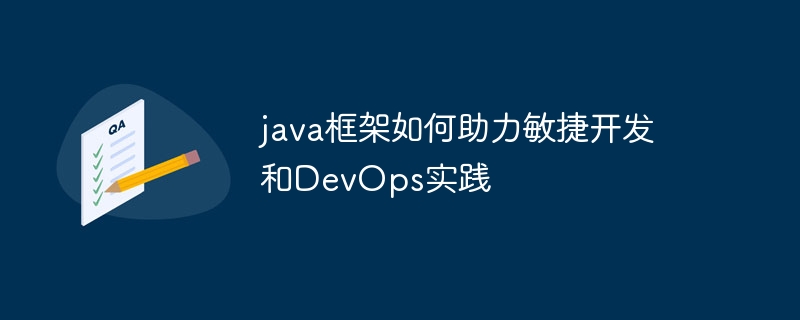The Java framework helps agile development and improves development efficiency and code quality by providing automated testing, continuous integration, event-driven architecture and other functions. In addition, the Java framework supports DevOps practices such as infrastructure as code, continuous deployment, monitoring and observability for efficient software delivery, ensuring environment consistency and fast fault handling.

How Java framework helps agile development and DevOps practices
In modern software development, agile methods and DevOps practices have become Crucial. Java frameworks provide strong support for agile development and DevOps, simplifying and automating the software development process by providing out-of-the-box components and tools.
Agile development
Agile development is an iterative and incremental software development method that emphasizes close collaboration with customers and rapid response to changes. The Java framework provides the following assistance for agile development:
- Automated testing: Test frameworks such as JUnit and TestNG can implement automated testing to ensure code quality and quickly identify defects.
- Continuous integration: Continuous integration tools such as Jenkins and Maven automate building, unit testing, and integration testing of code, facilitating rapid feedback loops.
- Agile documentation: Document generation tools such as Asciidoctor and Doxygen can create clear and concise documents to facilitate communication and collaboration among team members.
- Event-driven architecture: Event-driven frameworks such as Spring Boot and Vert.x support the development of loosely coupled components, enhancing scalability and ease of maintenance.
DevOps Practice
DevOps is the practice of bringing development and operations teams together to achieve efficient software delivery. The Java framework provides the following assistance for DevOps practices:
- Infrastructure as Code (IaC):IaC tools such as Spring Cloud and Terraform can automate infrastructure deployment and configuration to ensure the environment Consistency and repeatability.
- Continuous deployment: Continuous deployment tools such as Jenkins and CircleCI can automatically build, test and deploy code to the production environment, shortening the delivery cycle.
- Monitoring and logging: Spring Boot, log4j and other tools provide robust monitoring and logging functions to help teams quickly identify and solve problems.
- Observability: Tools such as Spring Boot Actuator and Micrometer provide in-depth application metrics and tracking data to enhance the team's visibility into system behavior.
Practical Case
Case 1: Agile Development
An e-commerce company developed a mobile application using the Spring Boot framework. The application is highly modular and uses an event-driven architecture to support high concurrency. Continuous integration tools are used to automatically build, test, and deploy applications after every code commit.
Case 2: DevOps Practice
A financial institution uses Jenkins and Terraform to implement DevOps practices. Jenkins automatically builds, tests, and deploys applications to test and production environments. Terraform automates the deployment and management of AWS infrastructure, ensuring environment consistency and repeatability.
Conclusion
Java framework provides strong support for agile development and DevOps practices by providing out-of-the-box components and tools. Through automation, observability, and continuous deployment capabilities, they help teams deliver high-quality software faster and more reliably.
The above is the detailed content of How java framework helps agile development and DevOps practices. For more information, please follow other related articles on the PHP Chinese website!
 C#开发经验分享:快速开发与敏捷开发方法论Nov 23, 2023 am 09:37 AM
C#开发经验分享:快速开发与敏捷开发方法论Nov 23, 2023 am 09:37 AM在C#开发的过程中,快速开发与敏捷开发方法论都是非常重要的,尤其是在现在快速变化的市场中。在本篇文章中,我将分享我的C#开发经验,重点关注快速开发与敏捷开发的方法论。一、什么是快速开发快速开发是为了快速响应市场需求,使产品能够尽早推出。这种开发方法可以大大缩短项目的开发周期,降低成本,并能根据用户需求进行快速迭代开发。快速开发需要一些具体的技术手段,例如采用
 Java大数据处理框架有哪些以及各自的优缺点?Apr 19, 2024 pm 03:48 PM
Java大数据处理框架有哪些以及各自的优缺点?Apr 19, 2024 pm 03:48 PM对于大数据处理,Java框架包括ApacheHadoop、Spark、Flink、Storm和HBase。Hadoop适用于批处理,但实时性较差;Spark性能高,适合迭代处理;Flink实时处理流式数据;Storm流式处理容错性好,但难以处理状态;HBase是NoSQL数据库,适用于随机读写。具体选择取决于数据需求和应用程序特性。
 如何使用go语言进行敏捷开发的实践与经验Aug 06, 2023 pm 03:19 PM
如何使用go语言进行敏捷开发的实践与经验Aug 06, 2023 pm 03:19 PM如何使用Go语言进行敏捷开发的实践与经验引言:在当今快节奏的软件开发领域,敏捷开发已经成为了一种非常流行的开发方法。它强调迅速适应变化,紧密合作团队和频繁交付价值。而Go语言作为一门高效、可靠且容易理解的语言,也越来越受到开发者的青睐。本文将介绍如何使用Go语言进行敏捷开发,以及一些实践经验和代码示例。一、使用Go语言的敏捷开发原则频繁交付:敏捷开发要求团队
 JPA还是MyBatis:选择合适的ORM工具的准则Feb 22, 2024 pm 09:57 PM
JPA还是MyBatis:选择合适的ORM工具的准则Feb 22, 2024 pm 09:57 PMJPA还是MyBatis:选择合适的ORM工具的准则,需要具体代码示例引言:在现代软件开发中,使用ORM(对象关系映射)工具是非常常见的。ORM工具能够将关系型数据库中的表与对象模型间进行映射,大大简化了开发过程。然而,在选择使用哪个ORM工具时,很多开发者常常感到困惑。本文将讨论如何选择适合的ORM工具,重点比较JPA和MyBatis,并给出具体的代码示例
 深入了解Java框架技术栈:探索Spring MVC、Hibernate、MyBatis等常用Java框架Dec 26, 2023 pm 12:50 PM
深入了解Java框架技术栈:探索Spring MVC、Hibernate、MyBatis等常用Java框架Dec 26, 2023 pm 12:50 PMJava框架技术栈:介绍常用的Java框架,如SpringMVC、Hibernate、MyBatis等随着Java的不断发展,越来越多的框架被开发出来以简化开发过程。其中,SpringMVC、Hibernate、MyBatis等是Java开发中最常用的框架之一。本文将介绍这些框架的基本概念和使用方法,帮助读者更好地理解和应用这些框架。第一,我们来介绍Sp
 PHP框架在敏捷开发和大型项目中的应用Jun 04, 2024 pm 01:42 PM
PHP框架在敏捷开发和大型项目中的应用Jun 04, 2024 pm 01:42 PMPHP框架在敏捷开发和大型项目中应用广泛,提供敏捷性、可扩展性和安全性等优势。例如,在电子商务网站中,Laravel框架可快速创建原型、处理复杂业务逻辑、确保安全和扩展功能。通过利用预定义的组件和设计模式,PHP框架为开发人员构建可扩展且维护良好的应用程序提供了便利。
 用 PHP 框架进行敏捷开发的方法Jun 03, 2024 pm 08:10 PM
用 PHP 框架进行敏捷开发的方法Jun 03, 2024 pm 08:10 PMPHP框架可为敏捷开发提供强大支持,遵循敏捷原则,包括增量开发、迭代、测试驱动开发和持续集成。Laravel框架通过提供测试驱动开发、快速迭代、持续集成和Scrum支持,为敏捷开发提供了全面的解决方案。
 java框架如何助力敏捷开发和DevOps实践Jun 06, 2024 am 10:26 AM
java框架如何助力敏捷开发和DevOps实践Jun 06, 2024 am 10:26 AMJava框架通过提供自动化测试、持续集成、事件驱动架构等功能,助力敏捷开发,提升开发效率和代码质量。此外,Java框架还支持DevOps实践,如基础设施即代码、持续部署、监控和可观测性,以实现高效的软件交付,确保环境一致性和快速故障处理。


Hot AI Tools

Undresser.AI Undress
AI-powered app for creating realistic nude photos

AI Clothes Remover
Online AI tool for removing clothes from photos.

Undress AI Tool
Undress images for free

Clothoff.io
AI clothes remover

AI Hentai Generator
Generate AI Hentai for free.

Hot Article

Hot Tools

VSCode Windows 64-bit Download
A free and powerful IDE editor launched by Microsoft

SublimeText3 Mac version
God-level code editing software (SublimeText3)

Zend Studio 13.0.1
Powerful PHP integrated development environment

mPDF
mPDF is a PHP library that can generate PDF files from UTF-8 encoded HTML. The original author, Ian Back, wrote mPDF to output PDF files "on the fly" from his website and handle different languages. It is slower than original scripts like HTML2FPDF and produces larger files when using Unicode fonts, but supports CSS styles etc. and has a lot of enhancements. Supports almost all languages, including RTL (Arabic and Hebrew) and CJK (Chinese, Japanese and Korean). Supports nested block-level elements (such as P, DIV),

SAP NetWeaver Server Adapter for Eclipse
Integrate Eclipse with SAP NetWeaver application server.







